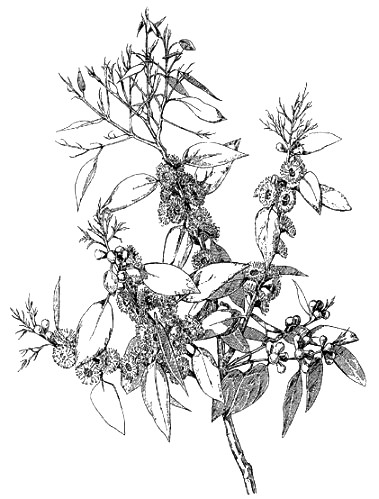Alfred Russel Wallace : Alfred Wallace : A. R. Wallace :
Russel Wallace : Alfred Russell Wallace (sic)
An Artist's Note-Book.
Eucalyptus Gunnii (S595b: 1902)
Editor Charles H. Smith's Note: A note printed in the 25 January 1902 issue of The Garden.
Original pagination indicated within double brackets. To link directly to this page, connect with:
http://people.wku.edu/charles.smith/wallace/S595B.htm
[[p. 57]] This species has rather a wide range, being found from South Australia to New
South Wales, and also in Tasmania, but always I believe on the higher mountains, and probably
in a dry soil, but I have been able to find no details on this point in any of the books I have access
to. It is one of the smaller species, its height in its native country being given as about 30 feet. It
is said (in "The Dictionary of Gardening") to be "perhaps the hardiest of all the species," and my
own experience shows that it is really "hardy" in the south of England, and probably in the north
also. The tree I now possess was raised by me from seed in 1887 or 1888 at Godalming. In June,
1889, I brought it to Parkstone in a pot it being then about 15 inches or 18 inches high. It was at
once planted on a bank of gravelly soil and about 20 feet from a deep railway cutting, so that its
roots were free from all superfluous moisture. Its first winter, 1889-90, was mild, and it grew
rapidly till the succeeding winter, when it was, I think, 6 feet or 7 feet high. The winter of 1890-91 was the first of a series of five which were exceedingly severe, but long continued frost did
not seem to injure this tree in the least, and it quickly grew above all shelter. Even the tips of the
growing shoots

Eucalyptus gunnii in flower.
(very slightly reduced.) (Drawn by Miss I. M. Charters.)
were only occasionally cut by the frost, while it bore the strongest gales, which caused its leading
shoots to bend and lash about like a slender whip-handle, with complete impunity. In 1896 it had
reached a height of about 25 feet and was of a fine pyramidal shape with a straight stem and
many lateral branches forming a fine bushy tree. But in the spring of 1897 a very heavy fall of
snow, which did great damage to both trees and telegraph wires, broke off about 8 feet or 10 feet
of the leading shoot. This caused one of the lateral branches near the ground to increase and
grow upwards, so that the tree now divides near the ground and seems to have two stems and a
fine bushy head. It has flowered regularly for the last five or six years, but more abundantly this
year than usual, and as the flowers were in perfection at Christmas they are very acceptable,
though not either large or highly coloured. The form and the delicate glaucous and somewhat
reddish tints [[p. 58]] of the foliage and young shoots are however very beautiful.
The trunk of this tree now measures 3 feet 6 inches round at a foot above the ground, and it is
I think about 30 feet high, while there seems every probability of its growing somewhat higher. It
has stood such severities both of frost and wind that I doubt if our very severest winters will
injure it, and it apparently requires only a dry and gravelly soil to grow rapidly into a very
beautiful small tree.
Alfred R. Wallace.
Parkstone, Dorset.
*
*
*
*
*
Return to Home
|

